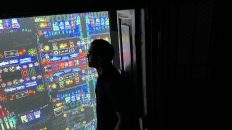Stunning site-specific installations takeover the historic Shahi Hammam and Summer Palace at the Lahore Fort
With the first-ever edition of the Lahore Biennale currently ongoing, site-specific installations by the award-winning artists Aisha Khalid and Imran Qureshi have become the focal point.

‘More Beautiful for Having Been Broken’ by Aisha Khalid is installed at different spaces of the
Shahi Hammam and consists of video projections, gouache on paper and a textile piece with gold plated steel pins. This site-specific work although spread across different spaces of the Shahi Hammam, makes a connection within itself and with the space. “As a Lahore based artist, I am experiencing a change in this city for more than three decades. The recent huge change we Lahoris are experiencing is a new concrete constriction around the city. In my memory, two very strong things, related to the colour orange come to mind: first, are the life jackets of Syrian refugees; and second, the modern transportation means, which is going to change this historical city forever.”

‘Hamam’ and ‘Story of Two 2018’ by Imran Qureshi can also be seen at the Shahi Hammam. 14 large scale paintings titled ‘Hamam’ installed at the historical site are focussed around the idea of ‘Blood Bath’ in the context of violence throughout human history and its political significance. The illusion of blood splashed marks on the large scale gold-leafed, gilded surfaces completely change the decorative characteristic and aesthetics of this Mughal Era monument into a harsher reality. As a part of this new body of work, a video installation titled ‘Story of Two 2018’ is also being exhibited in one of the rooms at the Shahi Hammam, with a strong personal/impersonal narrative.

Qureshi’s work can also be found at the Summer Palace, in the basement of the Shish Mahal at the Lahore fort. His work confronts the viewer with the stark reality of today’s artificial landscapes: a field of optic fibers, multiplied by mirrors to resemble an endless unnatural steppe. This is the present: the digital non-space, a completely abstract world with no relation to the locality, the handmade and the human. In a world of bleaching coral reefs, disappearing rainforests and drying lakes, only plastic landscapes are gaining ground.
Special Thanks to Lotus PR




